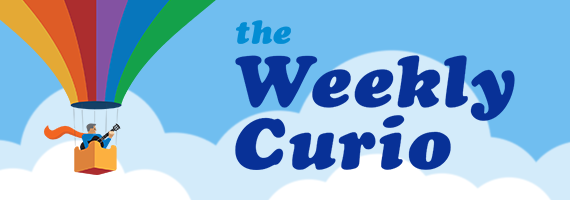Last week's Curios covered how to kill your iPhone, the most sampled song in the world, and Winnie the Pooh's ADHD.
Curio No. 941 | Don't set your iPhone to the Unix epoch!
We know the internet brings out the worst in people. But this is pretty bad. Last week an ad surfaced claiming you could experience a retro theme and a "wild ride" with your iPhone simply by setting its date back to January 1, 1970. Don't do it! This is a nasty trick exploiting a bug discovered last week on all 64-bit iPhones. Due to something called the Unix epoch, if you set your iPhone's date back to 1/1/70 it will crash and never restart! Unix time is a method of measuring time used by computer programmers around the world... keep reading.
Curio No. 940 | For the love of detangling
Deep inside an online knitting community called Ravelry.com lies a forum named Knot a Problem. It's a group of 3,000 knitters who love to detangle yarn. Outsiders come to Knot a Problem with messed up skeins--the technical term for coils of yarn, and my new word of the day!--and volunteers detangle the mess for only the cost of shipping. Some detanglers even pay for balls of tangled yarn just so they can have the pleasure of fixing them. Knot a Problem members share their techniques, post before-and-after photos (dubbed "tangle porn")... keep reading.
Curio No. 939 | The most mysterious manuscript in the 'qokeedy'
If you're like me, you'd never heard of the Voynich manuscript before this Curio. Often called the "most mysterious manuscript in the world," this 240-page codex was discovered in 1912 by a Polish rare-books dealer named Wilfrid Voynich. It contains drawings of mystical plants and astronomy charts--but most interestingly, it's written in an undecipherable language. Voynich, instantly enamored, dove into researching the book... keep reading.
Curio No. 938 | A do-it-your-selfie guide
Selfie-addicts, pay attention. A Stanford Ph.D. student has discovered the traits of a popular selfie. For fun, Andrej Karpathy gathered 2 million selfies from social networks and sorted them by "likes" relative to the number of people who had seen them. He then split the images into "good" and "bad" selfies. Finally, he fed both datasets into a convolutional neural network, or ConvNet. A ConvNet is a type of computer program that can be trained to recognize objects in pictures, conceptually. It emulates the way our brains are trained... keep reading.
Curio No. 937 | A legendary sample example
The last 30 years of music owe a lot to something called sampling--the process of taking a snippet of an existing recording and repurposing it in a new song. According to WhoSampled.com, the most sampled song of all time is "Amen, Brother," a B-side from the '60s R&B band The Winstons. Skip to 1:20 below, and you'll hear the six seconds of drumming that has gone down in history as the Amen Break. Everyone from N.W.A. to Oasis to David Bowie has used the Amen Break in their songs; and it has been especially impactful... keep reading.
Curio No. 936 | Love actually, the MRI version
On Friday, we learned how economists think about love. But what do other academic disciplines have to say about humans' need for affection? A team of psychologists and anthropologists has recently suggested love is not only real, but that it is closely related to addiction. The team, from Rutgers University, studied college students who had just left a long-term relationship and still had feelings for their ex. Researchers measured their brain activity while they were prompted to think about their former partners. Then the data was compared with that of happily-in-love participants. What the researchers found was pretty astounding... keep reading.
Curio No. 935 | (Over)analyzing Winnie the Pooh
Oh, bother! If you, like me, associate Winnie the Pooh with childhood innocence and adventure, you may not want to read this. Many academics are increasingly convinced Pooh carries a deeper significance. Theories range from religious symbolism to clinical psychology. One of the more disturbing analyses is titled "Pathology in the Hundred Acre Wood: a Neurodevelopmental Perspective on A.A. Milne." In the paper, the authors assert Milne's stories are intended to showcase textbook psychological disorders... keep reading.
Want more amusing facts? Check out the archive of 900+ Daily Curios, or sign-up for Curious.com to get the Daily Curio email delivered right to your inbox!

